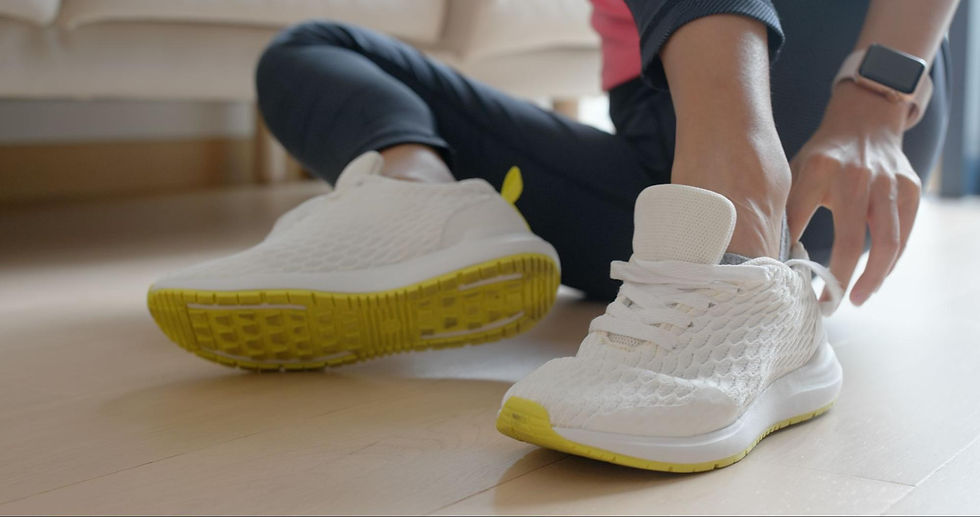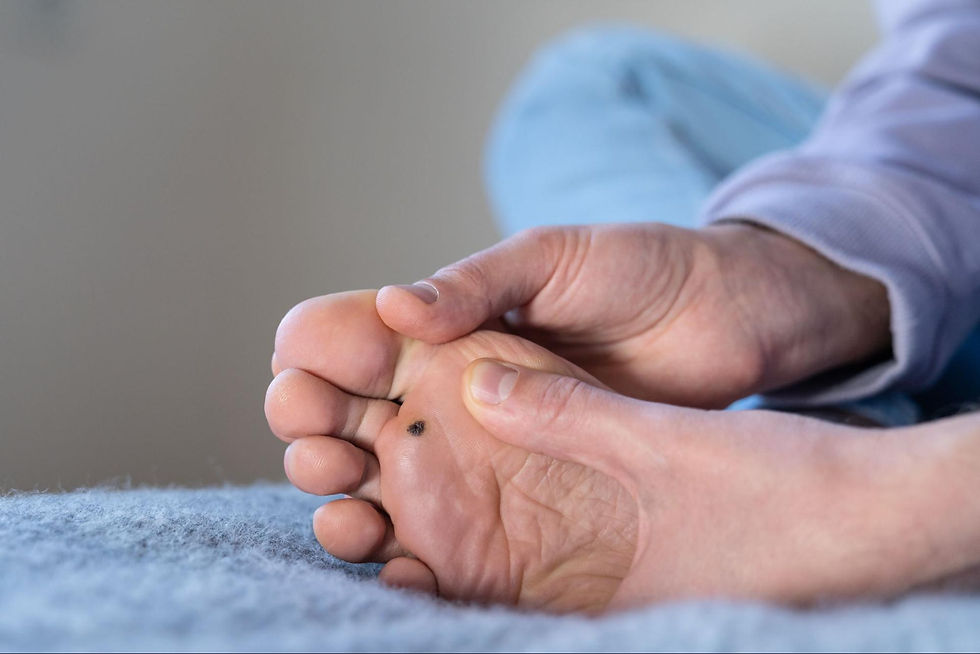A Complete Guide to Wart Treatments for Plantar Warts
- Foot & Ankle Specialists of Az

- Jun 16
- 7 min read

Plantar warts can be painful, persistent, and frustrating to deal with—especially when they interfere with your ability to walk or stay active. Fortunately, modern wart treatments offer a range of options that surpass the outdated remedies of the past. From drugstore solutions to in-office procedures, there's a method for almost every case. This guide covers everything you need to know about identifying, treating, and preventing plantar warts effectively.
Understanding Plantar Warts Before Exploring Wart Treatments
Before diving into wart treatments, it's essential to understand what plantar warts are and why they behave differently from other types of warts. Plantar warts are caused by the human papillomavirus (HPV) and appear on the soles of the feet. Due to the pressure from walking and standing, they often grow inward and can become extremely tender. Unlike other skin growths, plantar warts often have a rough, grainy surface and may show small black dots—clotted blood vessels. Because they form on weight-bearing areas, they can also be mistaken for corns or calluses. But unlike those, warts are caused by a viral infection and need targeted treatment.
Wart Treatments: When to See a Doctor for Plantar Warts
You don't always need medical intervention for plantar warts, but knowing when to seek help can save you months of discomfort. Wart treatments from a healthcare professional are especially recommended if:
The Wart is Growing or Spreading
If you notice that your plantar wart is getting larger or multiplying, it's a sign that the virus is active and spreading beneath the skin. In such cases, home remedies may not be strong enough, and medical treatment is recommended to prevent further infection or discomfort.
Over-The-Counter Treatments Have Failed
Not all warts respond to drugstore solutions like salicylic acid or freeze kits. If you've tried these consistently without improvement after several weeks, it's time to seek professional wart treatments that can offer more potent and targeted results.
You Have Diabetes or Compromised Immunity
Individuals with diabetes or weakened immune systems should never attempt to treat plantar warts on their own. Even minor skin issues can escalate into serious complications, so professional evaluation is crucial to ensure safe and effective treatment.
The Wart Causes Pain When Walking or Standing
When a plantar wart interferes with your ability to walk, exercise, or stand comfortably, it's more than a cosmetic concern—it's a functional problem. Painful warts may require more aggressive treatment methods to eliminate the source of pressure and discomfort.
Home-Based Wart Treatments for Plantar Warts
If you're dealing with a new or mild case, home wart treatments can be a great starting point. These treatments are accessible, affordable, and often effective when used consistently.
Salicylic Acid
Salicylic acid is a keratolytic agent that breaks down the thick skin layers of the wart. It's available in liquid, gel, pad, or plaster form. For plantar warts, it helps soften the tissue, allowing for gradual removal. Apply it daily and pair it with regular exfoliation using a pumice stone or emery board.
Duct Tape Method
The duct tape method has gained popularity as a home remedy for warts. Cover the wart with duct tape for six days, then remove it. Soak the area in warm water and gently debride the dead skin. Repeat until the wart disappears. Although clinical results are mixed, many individuals report success with this straightforward, low-risk approach.
Cryotherapy Kits
At-home cryotherapy kits use dimethyl ether and propane to freeze the wart. While less effective than professional treatments, they may be effective in treating smaller plantar warts if used early. The application involves spraying the freezing agent directly onto the wart for several seconds, which causes the tissue to die and slough off.
Professional Wart Treatments That Target Stubborn Plantar Warts
When over-the-counter options fall short, it's time to consider in-office wart treatments that are stronger and faster-acting. Dermatologists or podiatrists typically administer these methods, and they can be tailored to the severity of your case.
Clinical Cryotherapy
Medical-grade cryotherapy utilizes liquid nitrogen, which is significantly colder than the liquid nitrogen found in at-home kits. This method freezes the wart and surrounding tissue, causing a blister to form. After a few days, the dead skin and virus-infected cells shed naturally. Multiple sessions are often needed for complete clearance.
Cantharidin Treatment
Cantharidin is a blistering agent derived from the blister beetle. A doctor paints the solution directly onto the wart, causing a blister to form underneath it. The wart then lifts away from the skin. This wart treatment is particularly effective for plantar warts because it targets the virus beneath thick skin layers.
Electrosurgery and Curettage
In more aggressive cases, the wart may be surgically removed. This process involves numbing the area, scraping the wart with a curette, and burning the base with an electric current. It's quick but may leave scarring and is generally reserved for painful, recurring plantar warts.
Alternative Wart Treatments for Holistic and Resistant Cases
If you're looking for holistic or unconventional wart treatments, several options might appeal to those who prefer to avoid pharmaceuticals or invasive procedures.
Immunotherapy
This treatment involves stimulating the body's immune system to fight off the virus causing the wart. It may include injections of antigens directly into the wart or topical immune-response modifiers, such as imiquimod. Immunotherapy is often used when other methods fail, particularly for persistent plantar warts.
Laser Wart Removal
Laser therapy utilizes intense light energy to destroy the blood vessels that feed the wart, thereby starving it of nutrients. While this wart treatment can be costly, it is effective for deep plantar warts and generally leaves less scarring than surgical removal.
Natural Remedies
Some people opt for natural ingredients, such as apple cider vinegar, tea tree oil, or garlic. While these treatments lack consistent scientific backing, anecdotal evidence suggests they may have mild antiviral or exfoliating properties. However, results vary widely and use should be approached with caution in sensitive areas, such as the soles of the feet.
How Wart Treatments Work Differently for Children vs. Adults
Warts often affect children and teens due to their increased exposure to bare feet and developing immune systems. Wart treatments for younger individuals should consider skin sensitivity, compliance, and emotional tolerance. Doctors may prefer milder options like salicylic acid or cantharidin for kids, avoiding aggressive techniques unless necessary. Adults, particularly those with thicker skin or underlying health conditions, may benefit from a combination of methods for optimal results.
Combining Wart Treatments for Better Results
Sometimes, a single treatment isn't enough to eliminate plantar warts. Combining different wart treatments can enhance efficacy, particularly for larger or more deeply rooted warts. For example, you might use salicylic acid daily while scheduling cryotherapy every few weeks—or pair duct tape with immune-modulating creams. A healthcare provider can guide you on safe and effective combinations to accelerate healing.
Wart Treatments and Pain Management for Plantar Warts
Because plantar warts are located on pressure points of the feet, they often cause more pain than other
types of warts. This location makes pain management a critical component of wart treatments.
Over-The-Counter Pain Relief
NSAIDs like ibuprofen or acetaminophen can reduce inflammation and discomfort. These can be taken before or after in-office procedures to manage soreness from blistering or debridement.

Padded Insoles and Cushioning
Using cushioned insoles, donut pads, or gel heel inserts can relieve pressure on the wart site. This padding is especially helpful while waiting for the wart treatment to take effect, as it minimizes irritation during walking.
Soaking and Softening
Soaking the feet in warm water mixed with Epsom salt not only prepares the skin for treatment but also provides temporary relief from discomfort. It helps reduce stiffness and pain in the surrounding tissues.
Preventing the Need for Wart Treatments in the Future
Even after successful wart treatments, plantar warts can return. HPV thrives in warm, moist environments; therefore, prevention strategies are crucial for achieving long-term results.
Avoid Barefoot Contact in Public Areas
Locker rooms, pool decks, and communal showers are hotspots for HPV. Always wear flip-flops or water shoes in these environments to reduce the risk of exposure.
Keep Feet Dry and Clean
Change socks regularly, air out shoes, and use foot powders if you sweat heavily. Dry feet are less likely to foster wart-causing viruses.
Don't Pick or Shave Over Warts
Breaking the skin over a wart can cause the virus to spread to other areas of the foot—or even to different people. Always use separate tools for wart-affected skin, and sanitize afterward.
What to Expect During Wart Treatment Recovery
Patience is key when it comes to wart treatments. Many methods require consistent application over weeks or months before showing results. Warts may temporarily appear worse as they blister or peel, but this often indicates that the treatment is working. If, after 12 weeks of home treatment, there is no improvement—or if the wart becomes increasingly painful—it's time to consult a professional. Persistence combined with the proper method is usually the winning formula.
When Wart Treatments Aren't Enough: Living With a Chronic Wart
For a small percentage of people, plantar warts can become chronic, recurring even after multiple treatments. In these cases, managing the condition rather than curing it outright may be the most realistic outcome. Some podiatrists recommend scheduled cryotherapy sessions or ongoing immune-boosting regimens to suppress outbreaks. It's also important to monitor for any changes in the wart's appearance. If a lesion starts to bleed, changes shape, or develops unusual pigmentation, it's essential to rule out skin cancer with a biopsy—even though this is rare.
The Future of Wart Treatments: What's on the Horizon?
Emerging research into HPV vaccines, topical gene therapies, and next-gen lasers is showing promise in making wart treatments faster and more reliable. While most innovations are still in clinical trials, they could soon offer better solutions for those who suffer from recurring plantar warts. Gene-editing tools, such as CRISPR, and targeted immunotherapies are also being studied for their potential to eliminate HPV at its root, potentially providing permanent relief in the future.

Understanding Wart Treatments for Plantar Warts
Plantar warts are more than just a nuisance—they can affect your mobility, confidence, and quality of life. But with a full arsenal of wart treatments now available, there's no reason to let them linger untreated. Whether you choose a home remedy, professional intervention, or a combination of both, acting early and consistently gives you the best chance for full recovery. Always consult with a medical provider for persistent or painful plantar warts, especially if you have underlying health conditions. With the right strategy, you can get back on your feet—literally and figuratively.
For more expert insights on foot health and treatment options, explore our Foot and Ankle Specialists of Arizona blog—your trusted source for care and guidance.
.png)